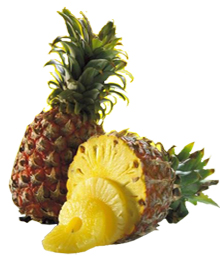| |
‘Ananas
comosus’ is the botanical name of
the fruit we know as the pineapple. Native to South
America, it was named for its resemblance to a
pine cone.
The name pineapple in English comes from the similarity of
the fruit to a pine cone. The word was first recorded in
1398, where originally used to describe the reproductive
organs of conifer trees (now termed pine cones). When European
explorers discovered this tropical fruit, they called them "pineapples" (term
first recorded in that sense in 1664) because they resembled
what are now known as pine cones. The term "pine cone" was
first recorded in 1694 to replace the original meaning of "pineapple"
In the scientific binomial ‘Ananas comosus’, ‘ananas’,
the original name of the fruit, comes from the Tupi (Rio
de Janeiro, Brazil) word for pine nanas, as recorded by André Thevenet
in 1555 and comosus means "tufted" and refers to
the stem of the fruit.Other members of the Ananas genus are
often called pine as well by laymen.
|
 |
|
|
| |
In Spanish pineapples are called ananá ("ananás",
in Spain) or piña (see the piña colada drink). A
large, sweet pineapple grown especially in Brazil is called abacaxi
.In Tamil (Indian Ancient Language) is called "Annachi Pazham".
In Bengali, pineapples are called "anarosh".
It was probably the Guarani Indians
who took pineapples on sea voyages as provisions
and to prevent scurvy, thus spreading the plants
from their native Paraguay throughout South
and Central America. They called it ‘nana’,
meaning "excellent fruit."
Christopher Columbus is credited with discovering the pineapple
on the island of Guadeloupe in 1493, although the fruit had long
been grown in South America. He called it piña de Indes
meaning "pine of the Indians."
Another explorer, Magellan, is credited with finding pineapples
in Brazil in 1519, and by 1555, the luscious fruit was being exported
with gusto to England. It soon spread to India, Asia, and the West
Indies.
Captain James Cook later introduced the pineapple to Hawaii circa
1770. However, commercial cultivation did not begin until the 1880s
when steamships made transporting the perishable fruit viable.
Once known as the fruit of kings, pineapple is a true exotic fruit
as for one thing, it is a member of the bromeliad family, in which
edible fruits are rare. In 1903, James Drummond Dole began canning
pineapple, making it easily accessible worldwide.
However, since pineapple was first canned and became a major crop
in Hawaii, we associate pineapple with Hawaii and the tastes of
the islands.
Today, Hawaii produces only ten percent of the world's pineapple
crops.India has been developing Pineapple Products and in the current
international food market the North East region Pineapple from
India has attained a respectable position. Other countries contributing
to the pineapple industry include Mexico, Honduras, Dominican Republic,
Philippines, Thailand, Costa Rica, China, and Asia.
Pineapple is thus the third most canned fruit behind applesauce
and peaches.
|
|
